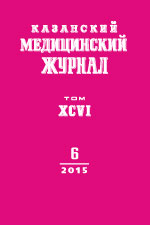Экспериментальное обоснование применения аутологичного модифицирования дентальных имплантатов на основе нетканого титанового материала со сквозной пористостью
- Авторы: Щербовских А.Е.1
-
Учреждения:
- Самарский государственный медицинский университет
- Выпуск: Том 96, № 6 (2015)
- Страницы: 1000-1003
- Раздел: Экспериментальная медицина
- Статья получена: 28.03.2016
- Статья опубликована: 15.12.2015
- URL: https://kazanmedjournal.ru/kazanmedj/article/view/1629
- DOI: https://doi.org/10.17750/KMJ2015-1000
- ID: 1629
Цитировать
Полный текст
Аннотация
Цель. Экспериментальное обоснование применения технологии аутологичного модифицирования дентальных имплантатов на основе нетканого титанового материала со сквозной пористостью с учётом показателей первичной стабильности штифта-распорки.
Методы. В рандомизированном исследовании использовано 20 препаратов нижней челюсти свиньи в возрасте от 9 до 13 мес. Методом периотестометрии проведена сравнительная оценка показателей стабильности моделей дентальных имплантатов на основе нетканого титанового материала со сквозной пористостью, установленных по традиционной технологии и с применением технологии аутологичного модифицирования с диаметрами штифтов-распорок 2,2 и 2,0 мм, выполненных в виде монолитных титановых стержней с гладкой поверхностью.
Результаты. Увеличение диаметра штифта-распорки с 2,0 до 2,2 мм в моделях дентальных имплантатов с втулкой из нетканого титанового материала со сквозной пористостью увеличивает показатели стабильности на 13,33 PT, с втулкой из нетканого титанового материала, модифицированного аутологичной костной тканью, - на 2,7 PT. Аутологичное модифицирование костной тканью нетканого титанового материала со сквозной пористостью увеличивает показатели стабильности имплантатов при диаметре штифта-распорки 2,0 мм на 13,49 PT, при 2,3 мм - на 2,86 PT.
Вывод. Стабильность модели дентального имплантата зависит от диаметра штифта-распорки внутрикостной части и плотности нетканого титанового материала со сквозной пористостью, регулируемой через аутологичную костную модификацию; результаты исследования позволяют шире использовать технологию аутологичного модифицирования дентальных имплантатов на основе нетканого титанового материала со сквозной пористостью в клинической практике.
Об авторах
Алексей Евгеньевич Щербовских
Самарский государственный медицинский университет
Автор, ответственный за переписку.
Email: scherbowskih@mail.ru
Список литературы
- Щербовских А.Е. Оценка биологической совместимости нетканого титанового материала со сквозной пористостью на культуре мультипотентных мезенхимальных стромальных клеток в эксперименте. Аспирант. вестн. Поволжья. 2014; 1-2: 210-213.
- Щербовских А.Е., Байриков И.М., Мизина П.Г. Дентальный имплантат (варианты). Патент на полезную модель №143685. Бюлл. №21 от 27.07.2014.
- Albrektsson T., Branemark P.I., Hansson H.A., Lindstrom J. Osseointegrated titanium implants. Requirements for ensuring a long-lating direct bone-to-implant anchorage in man. Acta Orthop. Scand. 1981; 52: 155-170. http://dx.doi.org/10.3109/17453678108991776
- Franchi M., Fini M., Martini D. et al. Biological fixation of endosseous implants. Micron. 2005; 36: 665-671. http://dx.doi.org/10.1016/j.micron.2005.05.010
- Joos U., Wiesmann H.P., Szuwart T., Meyer U. Mineralization at the interface of implants. Intern. J. Oral Maxillofacial Surg. 2006; 35: 783-790. http://dx.doi.org/10.1016/j.ijom.2006.03.013
- Kim J.E., Kang S.S., Choi K.H. et al. The effect of anodized implants coated with combined rhBMP-2 and recombinant human vascular endothelial growth factors on vertical bone regeneration in the marginal portion of the peri-implant. Oral Surg. Oral Med. Oral Pathol. Oral Radiol. 2013; 115: 24-31. http://dx.doi.org/10.1016/j.oooo.2011.10.040
- Lee J.K., Cho L.R., Um H.S. et al. Bone formation and remodeling of three different dental implant surfaces with Escherichia coli-derived recombinant human bone morphogenetic protein 2 in a rabbit model. Int. J. Oral Maxillofac. Impants. 2013; 28: 424-430. http://dx.doi.org/10.11607/jomi.2751
- Saber-Samandari S., Alamara K., Gross K.A. Micro-Raman spectroscopy shows how the coating process affects the characteristics of hydroxylapatite. Acta Biomater. 2013; 9: 9538-9546. http://dx.doi.org/10.1016/j.actbio.2013.08.021
- Wennerberg A., Albrektsson T. Effects of titanium surface topography on bone integration: a systematic review. Clin. Oral Implants Res. 2009; 20: 172-184. http://dx.doi.org/10.1111/j.1600-0501.2009.01775.x
- Wennerberg A., Albrektsson T. On implant surfaces: a review of current knowledge and opinions. Int. J. Oral Maxillofac. Impants. 2010; 25: 63-74.
Дополнительные файлы







